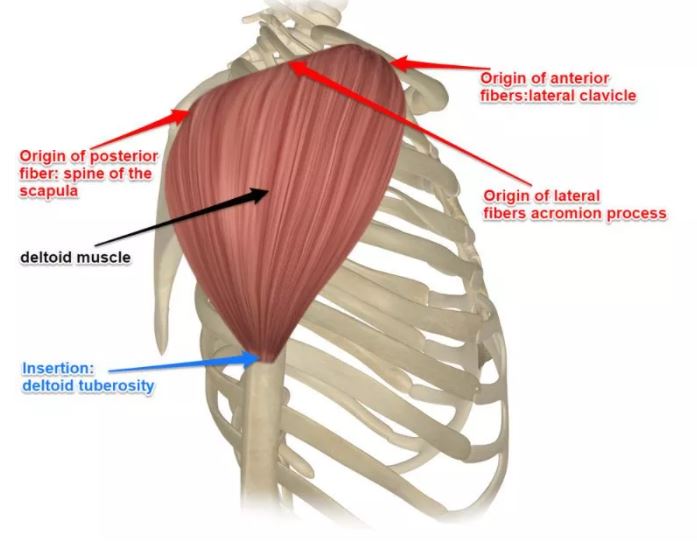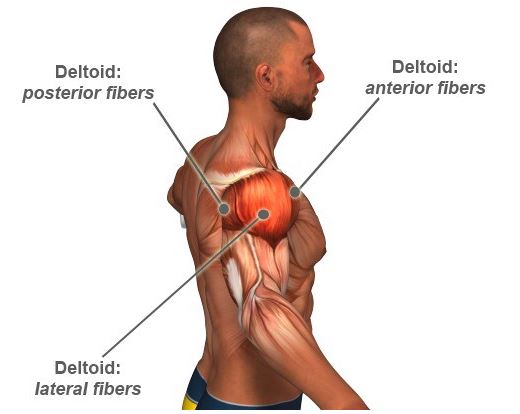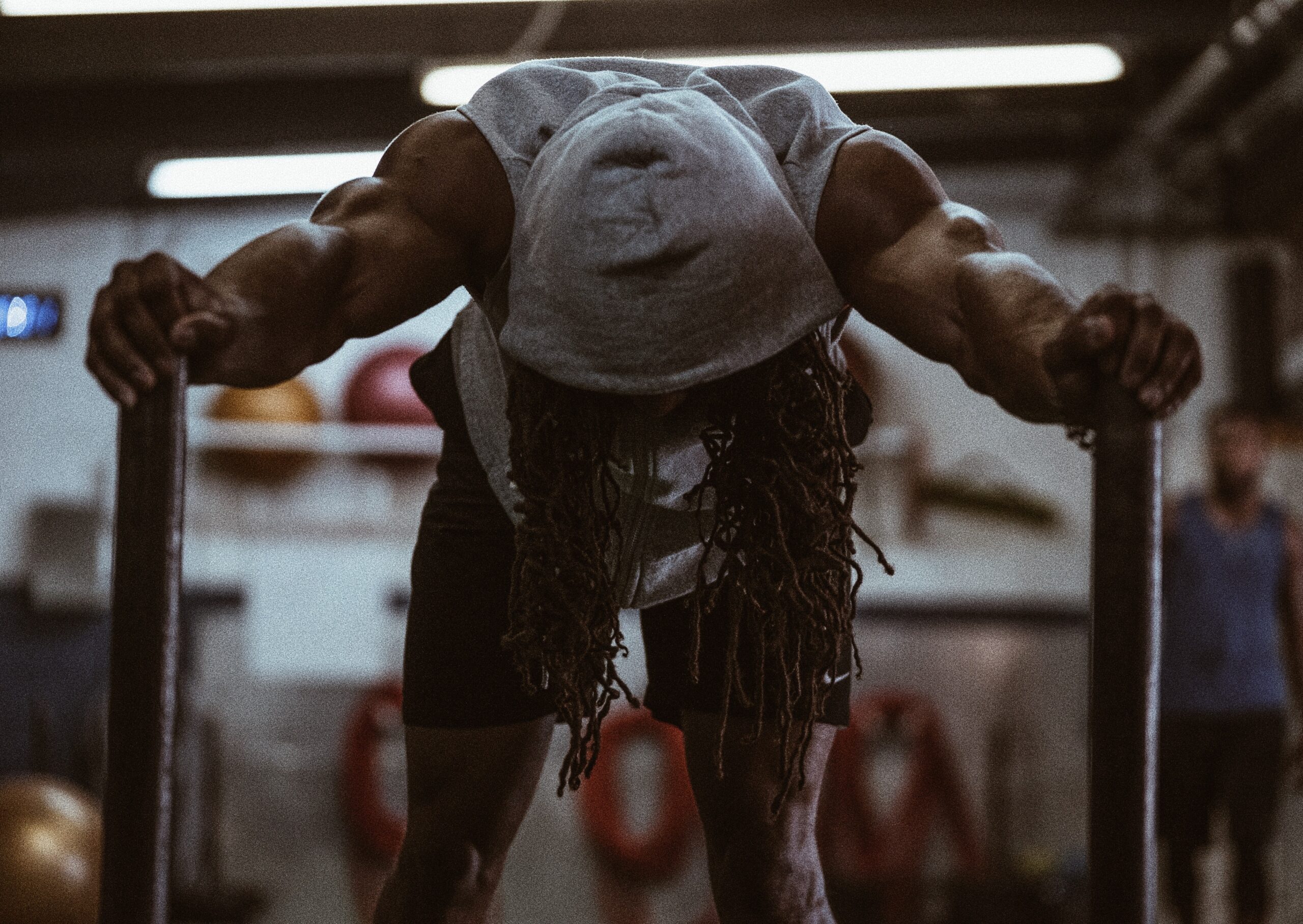Understanding the shoulder anatomy better will give you the opportunity to apply exercises for bigger shoulders! You will be able to build greater mass and more complete shoulders. Keep on reading!
The shoulder muscles are made up of the deltoids and the key muscles that help rotate the arm. The deltoids are the muscles that appear on the outer surface of the shoulders (in short, the muscles that surround it), while the joint muscles that help rotate our arms are located on the inside of the shoulder. Those muscles provide structural support and allow the shoulder to perform many different functions, such as the rotation.
The shoulder joint can be considered as the most mobile joint in the human body. This joint allows the bending, extension, abduction, adduction, rotation of the arm and the very complex movement of all the previous movements together in a fluid manner. Although what we have said so far, in fact allows the shoulder to move in almost any range of motion, unfortunately it is also proof that the shoulder is very sensitive to injuries, if the corresponding muscles are not trained properly and effectively!
Shoulder anatomy 6 exercises to increase mass
In terms of aesthetics and proportion to a physique, the deltoids are the muscles that provide width to the upper body and contribute to the well-known “V” formation of our torso, which most athletes desire. This shape results from the muscular shape of the shoulders and the maintenance of the slim waist.
It is not only the strong and fit deltoids that contribute to the prevention of shoulder injuries, but also a healthy muscle core inside the shoulders (the muscles that help rotate our arm).
The deltoids consist of 3 heads. The front head (anterior), the middle head (lateral), the rear head (posterior). While all 3 heads end up in the same part of the arm, they have different points of origin:

Anterior Deltoid (front)
The main function of the anterior deltoid is the flexion of the shoulders, in short, the elevation of our arm upwards. This function is isolated in exercises such as front shoulder presses with dumbbells.
The front deltoid is also involved in rotating the shoulders, that is, the movement that our raised hand makes from the outside to the center of our body (the movement made while on peck deck machine). This movement also includes the upper chest muscle group.
The anterior deltoid is particularly active with push-ups and chest flys, bench presses etc. This means that most athletes do not need to isolate frequently to achieve a good result in the physique of the front deltoid.
However, keep in mind that most shoulder imbalances and injuries are caused by excessive strain on the front deltoid, so the shoulder must be kept muscularly balanced. That way the joint is healthy and strong, injury free and with much better potential to grow. The isolating exercises that target our anterior deltoid provide functional benefits and muscle hypertrophy. Therefore, it is often important to perform exercises that target that muscle as well!
Exercise # 1: Front shoulder presses with dumbbells or barbells (The Overhead Press)https://www.youtube.com/watch?v=_RlRDWO2jfg
This is an exercise that targets the anterior deltoid (front) as well as the triceps, as a secondary muscle group. It allows us to lift weights and can help us significantly in the overall pressure force with our shoulders. This movement is a foundational tool for Powerlifters who want to increase their strength and the weightlifting capability in other exercises too such as the bench press.
However, for those who are interested in bodybuilding, there are special alternative exercises that better isolate the anterior deltoid and are ideal exercises especially if the anterior deltoid is not as developed.
More shoulder exercises and reading here.
Exercise # 2: Front shoulder extensions with pulley handle
This exercise is performed on the corresponding pulley instrument, where the handle is placed at the lowest level of the instrument and is raised in front of our body, up to shoulder height.
Performing this variation with the pulley or dumbbells, we create conditions of intense pressure and stimulation, directly in the anterior deltoid.
Lateral Deltoid (central/middle)

This is the main head of the deltoid, which contributes greatly to the overall width of the upper body structure.
Achieving the development of this deltoid muscle is extremely important for bodybuilders and, in general for all athletes desiring nicely ripped shoulder muscles.
The basic function of this head is to abduct the shoulders. This includes raising our arm to the side of your body. This muscle function can be isolated in exercises such as the Dumbbell Lateral Raise.
The central deltoid is much less involved in any other exercise. Therefore, the training of the central deltoid is special and requires attention, due to the specific range of motion of the specific head of the shoulders. Although functional problems may not be caused by an underdeveloped middle deltoid muscle it is still critical to exercise this muscle, to maintain a balanced and healthy joint in your shoulder.
Exercise # 3: Lateral Shoulder Extensions with Pulley Handle
LLateral lifting of the pulley handle is performed on the corresponding pulley instrument, with the handle adjusted to the lowest point. The handle is raised with one hand at a time, with the handle starting from the center of our body and ending at the side, up to shoulder height. Keep your elbows slightly bent, to achieve the desired isolation.
This exercise provides constant pressure to the central deltoid, due to the circular nature of the pulley cable resistance. This makes the lateral lifting of the handle extremely difficult, compared to the corresponding lateral lifting of a dumbbell. This is because the resistance of the lateral lifting of a dumbbell is exerted directly downwards due to gravity (and not sideways). This is the reason why this exercise is more effective than the dumbbell raises. It applies pressure and tension on the specific muscle, throughout the duration of the exercise. The shoulder should be held with a slight internal rotation, while performing the exercise.
The Posterior Deltoid (rear)

This side of the shoulder can be considered as the most important in terms of stability of our shoulder joint. It is very common for the posterior deltoid to be underdeveloped, as there is often the impression that this muscle is significantly involved in back exercises (such as unicycle and rowing). But this is not true! This muscle is much less involved in the respective back exercises. Keep in mind that this miscalculation can lead to serious structural problems of our shoulder joint, because this muscle comes from the spine of our lower body.
The function of the rear deltoid is transverse abduction. This involves moving the arm from the front of our body to the midline of our body. This function is the exact opposite movement to the movement we do in the chest flys and is associated with the exercise called Reverse Delta Flys. This exercise is often performed with the corresponding pulley machine, as described below.
Exercise # 4: Shoulder Abductors with Pulley Handle for Rear Deltoids (similar to a Wide Row movement)
This is a complex movement that directly targets the posterior deltoids, through the transverse abduction, while the trapezius also participates through the scapula. The rope or pulley bar can also be used, depending on your personal preference. Also the pulley handle can be used with one hand at a time, for even better isolation of the rear deltoid.
1. The exercise is performed with a pulley machine, with the cable aligning towards our body, placing the grip at shoulder height.
2. Stand upright with your torso straight and tight.
3. Exhale when pulling the handle towards you and pressing your shoulders.
4. Inhale as the handle moves away from your body and prepare for the next repetition.
The below example of a wide row with the TRX is a great alternative of the pulley exercise. See how the posterior deltoid is activated!
Exercise # 5: Reverse flys with pulley handles for rear deltoids
This movement is exactly the opposite of the movement of the chest flys. The handles leave the front of the body and come in a straight line with the shoulders, lateral to our body. These reverse flys allow the posterior deltoids of each shoulder to be successfully isolated. This exercise is ideal and can prevent imbalances between the left and right shoulder, because they allow the simultaneous and isomeric training of both posterior deltoids.
1. Stand upright with your torso straight.
2. Exhale while pulling the handles back to bring them in a straight line with the shoulders, while at the same time pressing hard on the shoulder muscles when you reach the end point of the repetition.
3. Inhale as you slowly return the handles to the inside of your body (in the starting position of the exercise) and prepare for the next repetition.
Exercise # 6: High Shoulder Abductors with Pulley Rope
In addition to training the posterior deltoids, this exercise also offers great stimulation to the external rotators of the shoulder, where the internal muscle fibers of the shoulder joint are located. This exercise can be important due to the inability to perform external shoulder rotations, which may have been caused mainly by the excessive development of internal shoulder rotations. These would have been caused by chest presses with dumbbells, chest flys etc.
Having a special exercise that focuses mainly on the external rotations of the shoulders can have many benefits, as it can reverse the internal rotation of the shoulders and provide balance between the muscles of the shoulder joint.
Proposed Shoulder workout plan
1. Front shoulder presses with dumbbells or barbell 1-3 x 6-12
2. Front shoulder extensions with pulley handle 3-5 x 6-12
3. Side Shoulder extensions with pulley handle 4-6 x 6-15
4. Shoulder abductors with pulley handle for rear deltoids 3 -5 x 6-12
5. Reverse flys with pulley handles for rear deltoids 1-3 x 6-12
6. Shoulder abductors with pulley rope in the direction of the face 3-5 x 6-15
Conclusion
In summary, you can plan to invest a higher percentage of your time and effort to master shoulder exercises that focus mainly on the lateral (middle) and posterior (back) deltoids. These are typically the heads that are underdeveloped due to the most frequent focus on chest exercises – heavily impacting the front deltoids. To achieve a greater result for overall bigger shoulder muscles and healthier joints, you need to add exercises to your routine targeting lateral and posterior deltoid muscles.
Need to work on your legs now?
Happy gains!!

